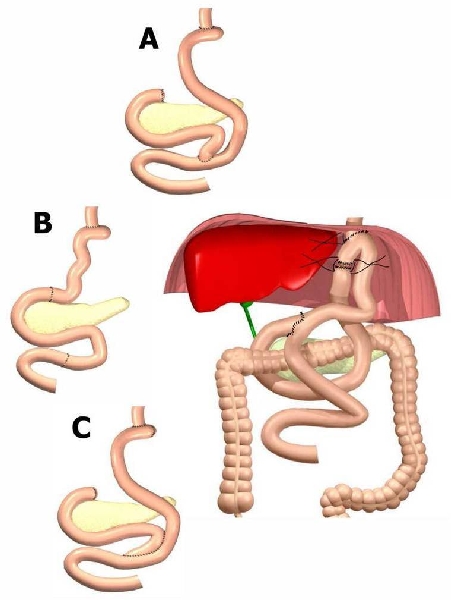Back to Program | 2010 Program and Abstracts Overview | 2010 Posters
Duodenum-Jejunum Dynamic Reservoir with Anti-Peristaltic Emptying After Gastric Resection (Safatle' Technique) Leads to Well Nourished Patients with Good Quality of Life
Nadim F. Safatle2, Ulysses Ribeiro*1,2, Adriana V. Safatle-Ribeiro1,2, Eduardo Berger3
1Gastroenterology, University of São Paulo, "Sao Paulo, SP", Brazil; 2Surgery, Hospital Sírio Libanês, São Paulo, Brazil; 3Surgery, Hospital Edmundo Vasconcelos, São Paulo, Brazil
The passage of food through duodenum is relevant for the maintenance of good nutritional status after gastric resection. We have developed a reconstruction technique following gastrectomy (Figure 1). Aim: To evaluate the long-term outcome of patients who underwent this type of reconstruction. Methods: 125 consecutive gastric cancer patients were evaluated through clinical, laboratorial, radiologic, scintigraphic and endoscopic examination. There were 88 men and 37 women with a mean age at the time of surgical treatment of 60.5 + 14.74 years. Follow-up varied from 2 to 25 years (mean = 11.4 years). Total gastrectomy was performed in 68 patients, subtotal gastrectomy in 45, postgastrectomy syndrome in 8 and total esophagogastrectomy in 4. Results: Laboratory analysis showed no evidence of iron deficiency (hemoglobin > 12 g/dl, ferritin > 10, serum iron > 60); or low serum albumin. Sixty percent of the patients gained weight, 20% lost and 20% maintained their weight. Radiologic and scintigraphic examinations demonstrated proper drainage of the contrast from the reservoir to the jejunum, without dilation or stasis. Emptying time varied from 60 to 180 minutes (mean = 122 minutes). Endoscopic examination revealed absence of alkaline reflux, or fluid stasis in the reservoir and easy visualization of the duodenal papilla. Conclusions: 1. The presented surgical technique is simple, efficient and safe with low rate of complications. 2. Long term follow-up demonstrated well nourished patients leading to a good quality of life.
Schematic representation of the Safatle’s technique that incorporates Roux-en-Y, small bowel interposition, and duodenum pouch with anti-peristaltic emptying.
Back to Program | 2010 Program and Abstracts Overview | 2010 Posters



